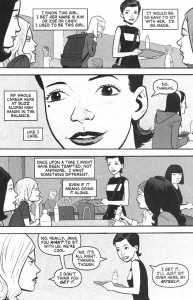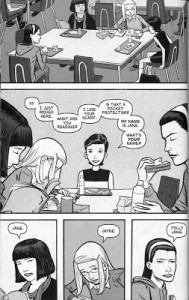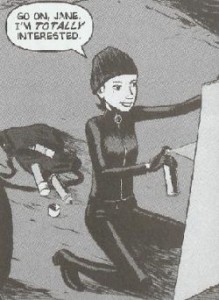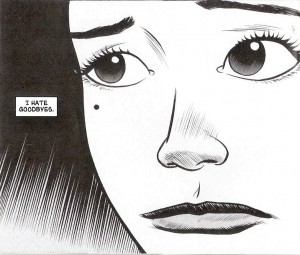 Welcome to Using Graphic Novels in Education, an ongoing feature from CBLDF that is designed to allay confusion around the content of graphic novels and to help parents and teachers raise readers. In this column, we examine graphic novels, including those that have been targeted by censors, and provide teaching and discussion suggestions for the use of such books in classrooms.
Welcome to Using Graphic Novels in Education, an ongoing feature from CBLDF that is designed to allay confusion around the content of graphic novels and to help parents and teachers raise readers. In this column, we examine graphic novels, including those that have been targeted by censors, and provide teaching and discussion suggestions for the use of such books in classrooms.
The Plain Janes is a graphic novel by written Cecil Castellucci and illustrated by Jim Rugg. It’s about Jane, who after barely surviving a terror attack in Metro City, must readjust to a “safer” life in suburbia. There, Jane decides that instead of sitting with the cool kids (where she used to belong in her previous school), she’d prefer a more interesting group of friends. She finds herself at a table with three other girls named Jane (or Jayne), and encourages them to form an all-girl gang: the P.L.A.I.N. Janes, or People Loving Art in Neighborhoods. This group incorporates Jane the athlete, Jane the artist, Jane the theater geek, and Jayne the science nerd. Through their “sabotage artistique,” Main Jane hopes they can save the disaster that is high school while showing her mom that the world’s not that scary a place.
In this relatively short 144-page graphic novel, Castellucci and Rugg tackle some big issues: surviving a terror attack, uprooting from a big city to suburbia, going through a complete make-over, finding one’s place and passions, and contemplating the meaning of life, art, and happiness. They do this through their nuanced characters, the use and layers of art, and the interspersing of quotes from Gandhi, Thoreau, and others.
The book opens with a blast (literally) and wonderful imagery. Jane, on her way to a math test is knocked down by a horrific explosion. While Castellucci and Rugg keep the details vague, we are led to believe this was a bomb. After recovering from the blast, Jane gathers her bearings noting there was “so much noise. And right there, right among the madness, right in the pavement — — was this tiny dandelion… I knew if that dandelion could survive — so could I.”
As Jane survives the terror attack, she also saves the life of John Doe, a man she finds unconscious on the street next to her. At the bomb scene, she finds and takes John Doe’s sketchbook (which has “Art Saves” on the cover). After she moves, she writes to him sharing her innermost thoughts and conflicts as she wrestles with her new life. It is from this sketchbook that Jane gets the idea of creating and leaving public displays of “art” throughout Kent Waters.
Jane, while shaken, reacts differently to the bomb than her parents. While Jane is a bit more cautious, her mom is outright spooked. Jane’s mom and dad decide it’s safer for them all in the suburbs, so they move to Kent Waters, about a day’s drive from Metro City. Before moving, Jane cuts her long blond hair and dyes it dark. With sketchbook in hand, Jane visits John Doe once more before leaving. While he’s still unconscious, she takes his book with her, telling him she’ll add to it and write to him.
As she enters suburban Buzz Aldrin High for the first time, Jane tells herself, “Here we go. Nothing worse than starting the school year six weeks late. Remember, it’s just four years…” To make matters worse, her mom keeps texting to check up on her, and then at lunch, while she’s invited by Cindy to sit at the cool kids’ table, Jane realizes, “It would be so easy to sit with her. I’d be made… Once upon a time I might have been tempted. Not anymore. I want something different. Even if it means going it alone.” Instead, she finds a table of Janes. While Jane (from now on referred to as Main Jane) is thrilled to be with them, the others are reluctant to accept her. Main Jane has to show them she means well. She has to earn their friendship, and she needs to find a way to make them a cohesive group.
 While writing to John Doe and looking at his sketchbook, Jane gets the idea of creating and leaving public displays of art throughout Kent Waters. She figures not only is this a way to unite the diverse interests of the Janes, but it’s a way to make everyone smile a bit more and a way to make her frightening dark life a bit brighter as well.
While writing to John Doe and looking at his sketchbook, Jane gets the idea of creating and leaving public displays of art throughout Kent Waters. She figures not only is this a way to unite the diverse interests of the Janes, but it’s a way to make everyone smile a bit more and a way to make her frightening dark life a bit brighter as well.
Inviting each Jane/Jayne to contribute their own skills, they agree to create P.L.A.I.N. (People Loving Art in Neighborhoods) Janes, a group that creates art out of the commonplace to inspire their community at large. Their first “sabotage artistique” is to create pyramids in the lot where a strip mall is set to go up. From there they build planet constellations, make stuffed animal dolls in front of the animal shelter with “Adopt a Pet” to help support the center, make bubbles in the town fountain, and gift wrap a statue (for starters).
While most of the Kent Water population admires the art, there are some who find them more “art attacks” than “art that saves.” The police, believing the attacks are high school student pranks and impose a curfew in the hopes of curtailing the attacks. No one likes that. So the gay kid, the cool kid, and eventually most of the Buzz Aldrin High students unite to support the glimpses of humor and color the art attacks bring.
One of the many things that make this story work is how Castellucci and Rugg introduce the Janes in distinct stereotypes (Brain Jayne, Main Jane, Theater Jane, and Sporty Jane), allowing them to grow out of their molds as the story unfolds and they become a team. Castellucci’s use of metaphor and her deep life questions are matched with Rugg’s detailed black and white drawings. Furthermore, the characters’ stories and stereotypes are balanced by real-life images of the girls. Some are cuter than others, thinner or heavier than others. They look and sound real and relatable. Furthermore, the concept of black and white art parallels the rigid thinking of the adults in the book as Jane grapples with life, art, and various shades of friendships.
Another reason this book works is because it deals with a post 9/11 culture in which adults appear more fearful, concerned, and suspicious and kids don’t always understand the implications. Castellucci does this with Jane’s dialogue with her friends, with Jane’s introspective letters to John Doe, with Jane’s parents’ overprotective rules, and with compelling, evocative images to support the text.
In short, The Plain Janes is about friendship, survival, the power or art, and finding oneself.
In addition to wonderfully nuanced characters and their ‘normal’ high school challenges, the story relays:
- The different ways we all work to survive in a post 9/11 world;
- The question of how to deal with fear: do we indulge it or work to overcome it;
- The question of whether art’s function is to sooth, reflect, and/or unsettle;
- The power of friendship, especially when things get tough;
- The power of persistence and cooperation with others to achieve your goals;
- Popularity does not insure happiness; and
- The difficulties of being uprooted and finding oneself and one’s place in a new environment.
 TEACHING/DISCUSSION SUGGESTIONS:
TEACHING/DISCUSSION SUGGESTIONS:
Plot, Themes, and Values Related
- Discuss Castellucci’s choice of names (for example: Metro City, Kent Waters, Main Jane, Brain Jayne, Polly Jane AKA Sporty Jayne, and Theater Jane). What do these names imply about their characters?
- Discuss and chart the different themes in this book.
- Throughout the book, Jane communicates with John Doe, whom she’s never met and who is unconscious throughout most of the story. Discuss why Jane feels so attached to him. Discuss why she takes his sketchbook. Finally, you may want to discuss how Castellucci uses this character to help define Jane and her issues.
- Discuss ways one can be “different” from others and the importance of “fitting in.” Why does Main Jane NOT want to sit with the cool kids, preferring to sit with the Janes?
- On pages 6-7, Jane tells us that her family as moved to Kent Waters, “Suburbia. As though anywhere is really safe.” Have students define what “safe” means to them, and the whether there are “safe places.”
Critical Reading and Making Inferences
- After the bomb, Jane and her parents (particularly her Mom) handle stress and fear very differently. Compare and contrast (bringing in text to support conclusions) how Jane’s reactions are different from her Mom’s. You may also want students to compare and contrast Jane’s reaction to stress with their own reactions to the stresses in their lives.
- Research and discuss post traumatic stress disorder (PTSD). Have students evaluate whom it affects and how it can be treated.
- Discuss and/or debate whether the sabotage art is a crime or not. Make sure students bring in text and/or primary sources to support their opinions.
- On page 62, Jane wonders, “Does art save?” Debate and discuss whether art saves, bringing concrete evidence to support the various positions.
- Cindy gives Jane all sorts of advice about surviving high school; for example, page 70, “If you keep sitting with rejects, it’ll rub off on you.” Have students collect Cindy’s advice and add their own. Students may also want to discuss why Jane doesn’t want to follow it and why she thinks the P.L.A.I.N. Janes are so much cooler.
- This book is all about navigating socially in high school after moving from Metro City to a smaller suburban community after a bomb exploded. Research and discuss different ways people have been known to react after surviving traumatic experiences.
- On page 58, Castellucci mentions the Case of the Meowing Nuns. Research and debate the circumstances of this case of mass hysteria (see link below).
- On page 88, Theatre Jane texts the group, “Gandhi said, ‘First they ignore you, then they laugh at you, then they fight you, the you win.’” Research the context in which this was said and discuss how it relates to what the Janes are doing here.
Language, Literature, and Language Usage
- Throughout the book, Castellucci uses imagery to relay what Jane’s thinking and how she’s adjusting to her new life. Have students search and reflect on her uses of language and imagery.
- Discuss the use of language and imagery as the book opens and right after the blast as Jane notices a dandelion, and thinks “ If the dandelion could survive so could I.” Discuss Castellucci’s choice of dandelion and the use of verbal and visual imagery.
- Define what Jane means when she says on p age10, “It’s hard to be a rebel with a leash.” Discuss her use of language and imagery with this quote.
- On page 24, Jane reflects, “Mr. Herrara said that Odysseus was brave and clever, and I said Hell no! He was a coward who had to hide inside a horse.” You may want to use this as bridge to introducing Homer’s Odyssey and/or discuss Castellucci’s use of this reference here.
- Read the Thoreau quote on page 54 in its original context: “What’s the use of a fine house if you haven’t got a tolerable planet to put it on…” (see link below). Analyze and discuss Thoreau’s intent after reading the quote from his letter to his fried Harrison Blake. Discuss how it is used here versus how it was used in the original.
- On Page 71, Officer Sanchez meets in front of the Buzz Aldrin High School and regarding the “sabotage artistique’” says, “We think they are kids. Kids like you. Only these kids don’t love their neighborhood. They deface and they call it art. Art is in a museum. Not on the streets.” With your class:
- Discuss what art is and come up with a class definition.
- Discuss and define street art. Split the class up and debate if street art and “sabotage artistique” are true art or not.
- On page 78, Jane notes, “The truth is, no matter how normal I try to be, I still feel like a shadow.” Have students create and share their own stories of feeling different and/or their stories of trying to fit in. Compare and contrast how the stories are told/ written, and chart the words used to relate their challenges and their feelings.
Cultural Diversity, Civic Responsibilities, and Social Issues
- Research, discuss and/or debate the argument of using community space for a mall versus using that space for art.
- On page 74, Jane writes to John, “Why is the world so full of hate?” Have students analyze and research different ways our country and communities deal with hate and discrimination. How are these reactions similar or different to other community/country reactions to hate and discrimination?
- Discuss how different cultures have dealt with hate. You may want to compare and contrast Dr. Martin Luther King’s peaceful protests with Gandhi’s. You may also want students to evaluate and discuss the Gandhi quote Castellucci uses on page 85, “First they ignore your, then they laugh at you, then they fight you, and then you win.”
 Define stereotypes your students come across in their lives. Discuss the pros and cons of using stereotypes and why they persist. For example, the cool kids’ table versus the Janes table.
Define stereotypes your students come across in their lives. Discuss the pros and cons of using stereotypes and why they persist. For example, the cool kids’ table versus the Janes table.
Content-Area Lessons:
- Math/History: On page 36, Brain Jane computes how to build pyramids. Discuss the math, engineering, and history of pyramid building.
- History: Discuss Gandhi’s philosophy of peaceful demonstration. Compare it to Dr. Martin Luther King’s.
- Language Arts/Philosophy: Discuss the quote on pate 134, “Tell me Miroslaw. If I do something beautiful and no one else sees it, is it still worth doing?”
Modes of Storytelling and Visual Literacy
In graphic novels, images are used to relay messages with and without accompanying text, adding additional dimension to the story. Compare, contrast, and discuss with students how images can be used to relay complex messages. For example:
- Discuss and evaluate Rugg’s use of black and white ink throughout the book. Evaluate how it changes to relate different emotions, events, and perspectives.
- Discuss and evaluate how Castellucci and Rugg depict the bomb attack. In particular, you may want to discuss how and why they let the audience infer the attack as opposed to defining and relaying it outright.
- Discuss the use of visual and literary metaphor as Jane focuses on, and compares herself to a dandelion (page 3) after the bomb. Discuss the imagery and intent of Jane noting, “I knew that if that dandelion could survive… so could I.”
 Suggested Prose and Graphic Novel Pairings
Suggested Prose and Graphic Novel Pairings
For greater discussion on literary style and/or content here are some prose novels and poetry you may want to read with The Silence of Our Friends
- Janes in Love by Cecil Castellucci and Jim Rugg — the sequel to The Plain Janes.
- Boy Proof and The Queen of Cool by Cecil Castellucci. Compare and contrast Castellucci’s stories, the language, and the use of art.
- 14 Cows in America by Carmen Agra Deedy — discuss how the Massai people in Kenya reacted to the story of 9/11 by sending a gift of 14 cows to the United States.
- With Their Eyes edited by Annie Thoms — relates how ten students from Stuyvesant High School (located near Ground Zero) interviewed community members and created a series of poems and monologues, sharing reactions to the terror attacks.
- My Sister Lives on the Mantelpiece by Annabel Pitcher — about how a family deals with the death of their sister/daughter who is killed in a terrorist attack in London.
- The Power of Art by Simon Schama — a nonfiction book that through vivid storytelling, explores eight classic pieces of art by Caravaggio, Bernini, Rembrandt, Turner, Van Gogh, Picasso and Rothko, telling us about the artists and the spirit of the times they lived through, shifting our awareness of art.
- Ways of Seeing by John Berger — based on the BBC television series, Berger helps us “see” art and look at pictures in very different ways.
Common Core State Standards:
The Plain Janes is full of advanced vocabulary, wonderful wordplay, inferences, nuanced characters, and humor. It can be effectively used with middle and high school students. It promotes critical thinking and its graphic novel format provides verbal and visual story telling that addresses multi-modal teaching, and meets Common Core State Standards. As it can be used for a range of ages and grade levels, we discuss below how it meets various Common Core Anchor standards.
- Knowledge of Language: Apply knowledge of language to understand how language functions in different contexts, to make effective choices for meaning or style, to comprehend more fully when reading or listening.
- Vocabulary Acquisition and Use: Determine or clarify the meaning of unknown and multiple-meaning words and phrases by using context clues, analyzing meaningful word parts, and consulting general and specialized reference materials; demonstrate understanding of figurative language, word relationships, and nuances in word meaning; acquire and use accurately a range of general academic and domain-specific words and phrases sufficient for reading, writing, speaking and listening at the college and career readiness level.
- Key ideas and details: Reading closely to determine what the texts says explicitly and making logical inferences from it; citing specific textual evidence when writing or speaking to support conclusions drawn from the text; determining central ideas or themes and analyzing their development; summarizing the key supporting details and ideas; analyzing how and why individuals, events, or ideas develop and interact over the course of the text.
- Craft and structure: Interpreting words and phrases as they are used in a text, including determining technical, connotative, and figurative meanings and analyzing how specific word choices shape meaning or tone; analyzing the structure of texts, including how specific sentences, paragraphs and larger portions of the text relate to each other and the whole; Assessing how point of view or purpose shapes the content and style of a text.
- Integration of knowledge and ideas: Integrate and evaluate content presented in diverse media and formats, including visually…as well as in words; delineate and evaluate the argument and specific claims in a text, including the validity of the reasoning as well as the relevance and sufficiency of the evidence; analyze how two or more texts address similar themes or topics in order to build knowledge or to compare the approaches the authors take
- Range of reading and level of text complexity: Read and comprehend complex literary and informational texts independently and proficiently
- Comprehension and collaboration: Prepare for and participate effectively in a range of conversations and collaborations with diverse partners, building on others’ ideas and expressing their own clearly and persuasively; integrate and evaluate information presented in diverse media and formats, including visually, quantitatively and orally; evaluate a speaker’s point of view, reasoning, and use of evidence and rhetoric.
- John Berger’s Ways of Seeing, Episode 1, https://www.youtube.com/watch?v=0pDE4VX_9Kk — John Berger examines the impact of photography and appreciation of art from the past.
- The source of Henry David Thoreau’s quote (found in a letter written to his friend Harrison Blake on May 20, 1860), along with other letters to Blake can be found and read on page 110 of this document along with a string of correspondences to Blake at http://www.walden.org/documents/file/Library/Thoreau/writings/correspondence/LettersBlake.pdf
- To review and discuss the Case of the Meowing Nuns, please visit The British Journal of Psychiatry and their article on the Protean nature of mass sociogenic illness at http://bjp.rcpsych.org/content/180/4/300.full
Meryl Jaffe, PhD teaches visual literacy and critical reading at Johns Hopkins University Center for Talented Youth Online Division and is the author of Raising a Reader! and Using Content-Area Graphic Texts for Learning. She used to encourage the “classics” to the exclusion comics, but with her kids’ intervention, Meryl has become an avid graphic novel fan. She now incorporates them in her work, believing that the educational process must reflect the imagination and intellectual flexibility it hopes to nurture. In this monthly feature, Meryl and CBLDF hope to empower educators and encourage an ongoing dialogue promoting kids’ right to read while utilizing the rich educational opportunities graphic novels have to offer. Please continue the dialogue with your own comments, teaching, reading, or discussion ideas at meryl.jaffe@cbldf.org and please visit Dr. Jaffe at http://www.departingthe text.blogspot.com.
We need your help to keep fighting for the right to read! Help support CBLDF’s important First Amendment work by visiting the Rewards Zone, making a donation, or becoming a member of CBLDF!
All images (c) Cecil Castellucci and illustrated by Jim Rugg.



